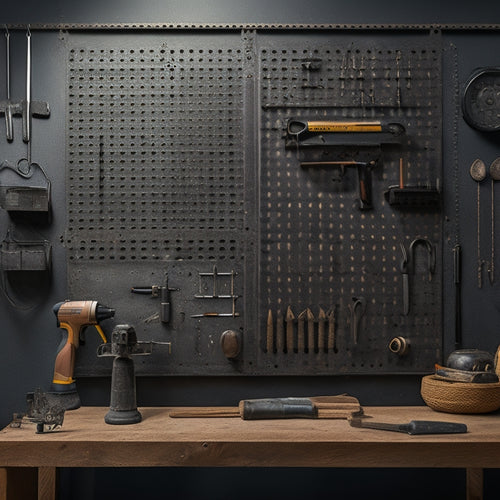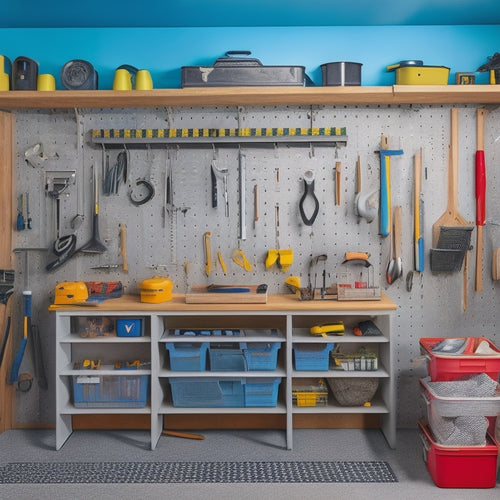
Top Woodworking Project Management Tools Reviewed
Share
You're looking for the top woodworking project management tools to streamline your projects and stay on track. Consider tools that allow you to create and manage tasks, set deadlines, and assign responsibilities to team members. Effective project planning, time tracking, and expense management are also pivotal. You'll want tools that enable real-time collaboration, customizable dashboards, and integrations with other software. From design software for 2D/3D models to expense tracking features, the right tool can make all the difference. Explore the top tools and essential features to find the perfect fit for your woodworking projects and take your organization to the next level.
Key Takeaways
• Look for project management tools that offer customizable dashboards, real-time collaboration, and built-in time tracking and expense reporting features.
• Ensure the tool allows for task hierarchy, deadline management, and effective progress tracking to maintain project momentum.
• Consider tools that integrate with design software for 2D/3D models and material selection guides to streamline project planning.
• Choose a tool that enables accurate resource allocation, data-driven decision making, and robust time tracking and scheduling.
• Select a tool that offers transparent expense management, clear communication strategies, and effective client feedback mechanisms.
Essential Features to Consider
When selecting a woodworking project management tool, consider the following important features that will help you streamline your workflow and stay organized.
You'll want a tool that allows you to:
- Create and manage tasks
- Set deadlines
- Assign responsibilities to team members
Another key aspect is the ability to track progress and collaborate with others in real-time.
Look for software options that offer a centralized platform for:
- Storing and sharing project documents, such as plans, invoices, and receipts
Additionally, consider a tool with:
- Built-in time tracking and expense reporting features to help you stay on top of your project's financials
A customizable dashboard and reporting capabilities are also vital, as they'll enable you to:
- Visualize your project's progress
- Make data-driven decisions
Finally, make sure the tool integrates with other software you use, such as accounting or design programs.
Top Tools for Woodworking Projects
As you prepare to tackle your woodworking project, you'll want to equip yourself with the right tools to guarantee success. You'll need to prioritize project planning essentials, such as setting realistic timelines and budgets, to get your project off on the right foot.
Next, you'll want to explore task organization systems that help you break down complex projects into manageable tasks.
Project Planning Essentials
You'll need to gather essential tools to plan your woodworking project effectively, starting with a reliable design software that allows you to create precise 2D and 3D models of your project. This will help you visualize your design, identify potential issues, and make necessary adjustments before you even start cutting wood.
In addition to design software, you'll also need to account for material selection and tool maintenance. These are critical components of project planning that can make or break your project's success.
Here's a breakdown of these essential planning tools:
| Tool | Function | Benefits |
|---|---|---|
| Design Software | Create 2D/3D models | Visualize design, identify issues |
| Material Selection Guide | Choose suitable materials | Ensure durability, stability |
| Tool Maintenance Schedule | Keep tools in good condition | Prevent damage, account for accuracy |
Task Organization Systems
To effectively manage your woodworking project, organize tasks using a system that breaks down complex projects into manageable chunks, assigns realistic due dates, and tracks progress. This will help you stay focused and avoid feeling overwhelmed by the scope of your project.
Here are four essential features to look for in a task organization system:
-
Task Hierarchy: Break down large tasks into smaller, actionable steps to maintain momentum and clarity.
-
Deadline Management: Set realistic due dates for each task to make sure you're on track to meet your project timeline.
-
Progress Tracking: Easily track your progress and identify areas where you need to adjust your schedule or approach.
- Collaboration Tools: Invite team members or stakeholders to collaborate on tasks, share files, and communicate in real-time.
Project Planning and Organization
Effective project planning and organization start with defining your project's scope, identifying major tasks, and breaking them down into manageable chunks. This sets the foundation for a well-structured project that's easy to manage and execute.
As you plan, you'll want to prioritize tasks, allocate resources, and establish a material inventory to guarantee you have everything you need. A clear plan also enables you to track progress, identify potential bottlenecks, and make adjustments to maintain project efficiency.
When organizing your project, consider the resources you'll need, including tools, equipment, and labor. Resource allocation is critical to staying on schedule and within budget. You'll also want to develop a system for tracking progress, which will help you identify areas for improvement and make data-driven decisions.
Time Tracking and Scheduling
With a solid plan in place, you're ready to turn your attention to scheduling and tracking the time it takes to complete each task, making sure you stay on pace to meet your project deadline. Effective time tracking and scheduling are vital to successful woodworking project management. You need to allocate resources efficiently, prioritize tasks, and monitor progress to avoid delays and costly overruns.
Here are four essential benefits of implementing a robust time tracking and scheduling system:
-
Accurate resource allocation: Assign tasks to the right team members, making sure each person has the necessary skills and expertise to complete the task efficiently.
-
Improved progress tracking: Monitor task completion rates, identify bottlenecks, and make adjustments to stay on schedule.
-
Enhanced team collaboration: Make sure all team members are on the same page, working towards a common goal, and aware of their responsibilities.
- Data-driven decision making: Analyze time tracking data to identify areas for improvement, optimize workflows, and make informed decisions for future projects.
Budgeting and Expense Management
Your woodworking project's financial success hinges on creating and sticking to a realistic budget. This means accurately estimating costs, tracking expenses, and making adjustments as necessary. A well-planned budget helps you allocate resources effectively, ensuring you have the necessary materials, tools, and labor to complete your project on time and within budget.
Effective expense tracking is vital to staying on top of your project's finances. You need to account for every dollar spent, from lumber and hardware to equipment rentals and labor costs. This helps you identify areas where you can cut costs and make adjustments to stay within budget.
Look for project management tools that offer expense tracking features. These tools allow you to log and categorize expenses, attach receipts, and generate reports to track your spending.
Collaboration and Client Management
You'll need to manage relationships and communicate seamlessly with clients, contractors, and team members to guarantee everyone is on the same page throughout the project. Effective collaboration and client management are vital to delivering successful woodworking projects on time and within budget.
Here are some key aspects to focus on:
-
Clear Communication Strategies: Develop a plan for regular updates, progress reports, and issue escalation to secure client satisfaction.
-
Real-time Team Collaboration: Use tools that enable simultaneous file editing, commenting, and task assignment to streamline workflows.
-
Client Feedback Mechanisms: Establish a system for collecting and incorporating client feedback to ensure their requirements are met.
- Transparency and Accountability: Set clear expectations and track progress to uphold trust and confidence with clients and team members.
Frequently Asked Questions
Can I Use Woodworking Project Management Tools for Personal Projects?
You're likely one of the 61% of DIYers who spend more time planning than building; using woodworking project management tools for personal projects can boost efficiency, streamline organization, and get you back to creating your DIY masterpieces.
Are These Tools Compatible With Mobile Devices and Tablets?
When managing personal woodworking projects, you'll want tools that are mobile-compatible, ensuring a seamless user experience. Most tools offer tablet functionality, allowing you to access project details and optimize efficiency on-the-go.
Do I Need Prior Experience to Use Woodworking Project Management Software?
You're not thrown into the deep end with woodworking project management software; a beginner's skill level is often sufficient. Most tools offer a user-friendly interface, and if you need a hand, training and technical support are usually just a click away.
Can I Customize the Tools to Fit My Specific Woodworking Business Needs?
You can tailor the tools to fit your unique needs by exploring customization options, which often include adding specific features, modifying workflows, and integrating with existing systems to create a tailored solution.
Are There Any Free Trials or Free Versions of These Project Management Tools?
Before committing to a tool, you'll want to explore free trials or versions to compare features and gauge cost effectiveness, ensuring the best fit for your woodworking business needs and budget.
Related Posts
-

Heavy-Duty Pegboard Hooks for Industrial Use
You need heavy-duty pegboard hooks that can withstand the rigors of industrial use, providing a reliable and efficien...
-

Advantages of a Pegboard System in Your Garage
You can instantly alter your garage into a more organized, efficient, and productive space by installing a pegboard s...
-

Top Rolling Tool Box Drawers for Maximum Storage
When it comes to maximizing storage with rolling tool box drawers, you need a solution that combines durability, cust...


